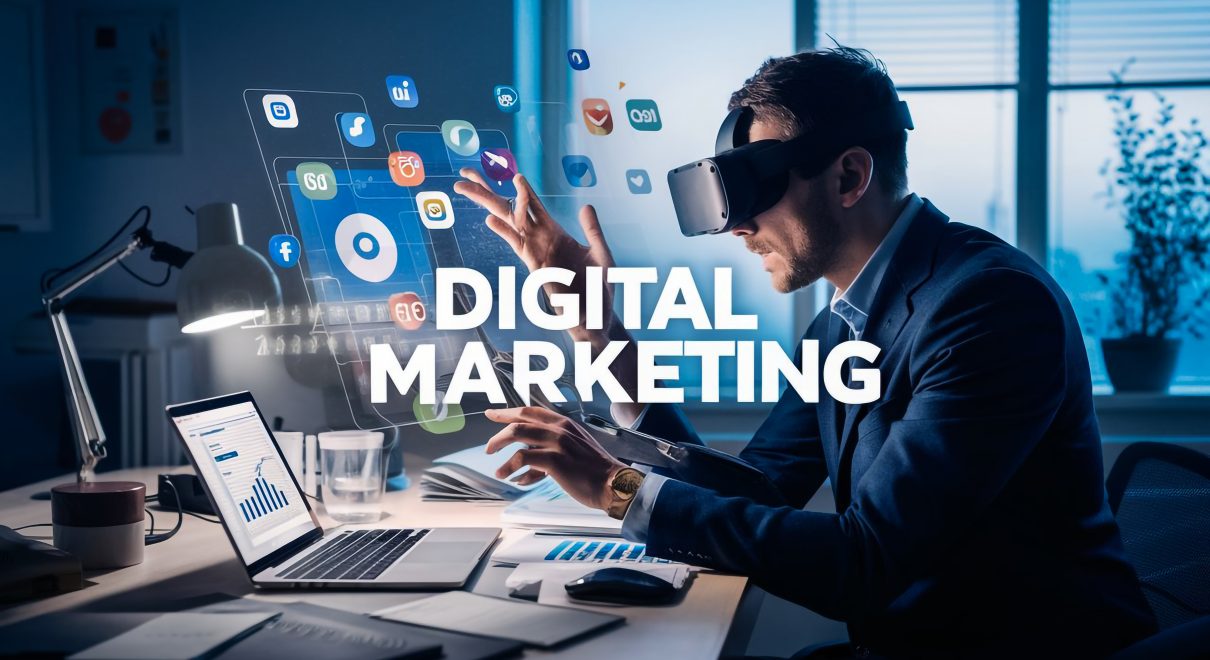Digital marketing is promoting products or services using digital technologies and channels. Unlike traditional marketing methods, which rely on mediums like print, television, and radio, digital marketing harnesses the power of the internet and electronic devices to connect businesses with their target audiences in real-time. In today’s rapidly evolving business environment, digital marketing has emerged as a critical component of any successful business strategy. As consumers increasingly turn to online platforms for shopping, information, and entertainment, the importance of digital marketing cannot be overstated.
A brand for a company is like a reputation for a person. You earn reputation by trying to do hard things we.
What is digital marketing?
Digital marketing refers to the use of online channels, platforms, and strategies to promote products, services, or brands to a targeted audience & enables businesses to engage with customers in real-time, measure campaign effectiveness, and reach a global audience with precision.
Key Components of Digital Marketing
- Search Engine Optimization (SEO)
- Optimizing websites to rank higher in search engine results pages (SERPs) to attract organic traffic.
- Content Marketing
- Creating and distributing valuable content (blogs, videos, and infographics) to engage and educate the target audience.
- Social Media Marketing
- Promoting brands and engaging with audiences on social media platforms like Facebook, Instagram, Twitter, and LinkedIn.
- Pay-Per-Click (PPC) Advertising
- Running paid ads on platforms like Google Ads or social media, where advertisers pay each time their ad is clicked.
- Email Marketing
- Sending targeted and personalized emails to nurture relationships, inform subscribers, and drive conversions.
- Affiliate Marketing
- Partnering with affiliates to promote products or services in exchange for a commission on sales generated through their referrals.
- Influencer Marketing
- Collaborating with influencers to promote products or services to their followers, leveraging their reach and credibility.
- Analytics and Reporting
- Using data analytics tools to track, measure, and optimize digital marketing efforts based on performance metrics.
- Conversion Rate Optimization (CRO)
- Improving the effectiveness of a website or landing page to increase the percentage of visitors who take desired actions.
- Mobile Marketing
- Reaching and engaging customers through mobile channels, including apps, SMS, and mobile-friendly websites.

Digital Markeitng Process
The digital marketing process is a structured approach that helps businesses reach their target audience, engage with potential customers, and achieve their marketing goals. By following a systematic process, businesses can create effective digital marketing campaigns that drive growth and deliver measurable results. Here’s an overview of the key steps involved in the digital marketing process:
1. Research and Strategy Development
The foundation of any successful digital marketing campaign lies in thorough research and strategic planning.
- Audience Analysis: Understanding your target audience is crucial. This involves identifying their demographics, preferences, online behaviors, and pain points. Tools like Google Analytics, social media insights, and customer surveys can provide valuable data.
- Competitor Analysis: Analyzing your competitors’ digital marketing strategies helps identify opportunities and gaps in the market. Understanding what works for your competitors can inform your own strategy and differentiate your brand.
- Setting Goals and KPIs: Establishing clear, measurable goals is essential. Whether it’s increasing website traffic, generating leads, or boosting sales, your goals should align with your overall business objectives. Key Performance Indicators (KPIs) are metrics that will help you track progress toward these goals.
2. Content Creation and Optimization
Content is the backbone of digital marketing. Creating high-quality, relevant content that resonates with your audience is key to attracting and retaining customers.
- Content Strategy: Develop a content plan that outlines the types of content (blogs, videos, infographics, social media posts) you’ll create, along with a content calendar to ensure consistent publishing.
- SEO Best Practices: Search Engine Optimization (SEO) is critical for ensuring your content is discoverable by search engines. This involves optimizing content with relevant keywords, meta descriptions, and high-quality backlinks.
- Content Creation: Craft engaging, informative, and valuable content that addresses the needs and interests of your target audience. This content should align with the goals set in your strategy and be tailored to each stage of the customer journey.
3. Distribution and Promotion
Creating great content is just the beginning; promoting it effectively ensures it reaches the right audience.
- Multi-Channel Promotion: Leverage various digital channels such as social media, email marketing, and paid advertising to distribute your content. Each channel has its strengths, so it’s important to choose the ones that best align with your audience and goals.
- Organic vs. Paid Strategies: Organic strategies, like SEO and social media engagement, help build long-term visibility, while paid strategies, such as pay-per-click (PPC) ads, can deliver immediate results. A balanced approach often works best.
- Social Media Marketing: Engage with your audience on platforms like Facebook, Instagram, Twitter, and LinkedIn. Social media is not only a distribution channel but also a space for interacting with customers and building brand loyalty.
4. Monitoring and Analytics
Tracking the performance of your digital marketing efforts is essential for continuous improvement.
- Performance Tracking: Use analytics tools like Google Analytics, social media insights, and CRM software to monitor how your campaigns are performing. Track key metrics such as traffic, engagement, conversion rates, and ROI.
- Data Analysis: Analyze the data to identify what’s working and what’s not. Look for trends and patterns that can inform future strategies. For example, if a particular blog post is generating a lot of traffic, consider creating more content on that topic.
- Optimization: Based on your analysis, make necessary adjustments to your campaigns. This might involve tweaking your content, reallocating your budget, or targeting a different audience segment. The goal is to optimize your efforts to achieve the best possible results.
5. Conversion and Customer Retention
Converting prospects into customers is a key goal of digital marketing, but retaining those customers is equally important.
- Conversion Optimization: Focus on improving the elements that drive conversions, such as landing page design, call-to-action buttons, and user experience. A/B testing can help determine the most effective approaches.
- Lead Nurturing: Use email marketing, retargeting ads, and personalized content to nurture leads through the sales funnel. Providing value at every stage of the customer journey increases the likelihood of conversion.
- Customer Retention: Once a prospect becomes a customer, the goal shifts to retention. Strategies like loyalty programs, personalized offers, and regular communication can help keep customers engaged and encourage repeat business.




